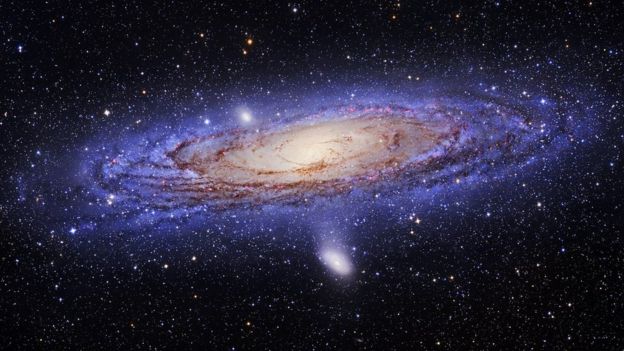
By Breanna Draxler | February 14, 2013 @ Look at This: Colorful Birthplace of Galaxy?s Youngest Black Hole : 80beats
Follow along with the video below to see how to install our site as a web app on your home screen.
Note: This feature may not be available in some browsers.

A binary system, is of course, one made of two componentssometimes two stars, others times as with Swift J1357.2, a star and a black holethe remnant of a star that exploded. In the latter case, the binary is known as an X-ray binary system because the accretion disk that develops between the two occasionally emits X-rays. The accretion disk is a mass of material that has been pulled from the star by the black hole. In this new research, the team has found evidence of a structure on the outer portion of the accretion disk that causes a dimming of the systemone that cannot be explained by the companion stars' orbit around the system's center of mass, which in this case, is one of the shortest ever seen, just 2.8 hours. The dimming, the researchers report occurs sometimes as often as every few seconds.
The researchers don't know what the structure is, but have found that it does not demonstrate periodic variation, an indication that it's vertical, and that it is capable of hiding the black hole from view. They report also that it behaves like a wave, moving through the disk in an outward direction, which accounts for the rapid dimming.

Simulation of the X-ray binary system Swift J1357.2-0933. In this view, the dips produced by the vertical structure are maxima.
That the structure appears capable of hiding the black hole from view is important because space researchers have been baffled by the apparent lack of black holes that should be evident in observations made from Earth. After a half century of study and analysis, only 18 have been confirmed to exist in the Milky Way and none of those have an eclipse that would cause X-ray emissions to be blocked. Scientists have theorized that many black holes cannot be seen due to the angle at which they exist relative to usthis new research suggests it could also be due to structures similar to the one observed in the accretion disk of Swift J1357.2, blocking their X-ray emissions.
Read more at: Researchers find 'structure' in black hole accretion disk

The monsters Dr. Broderick has in mind are supermassive black holes: terrifying giants that lurk in the hearts of galaxies, including our own, where they can devour stars and interstellar gas like cosmic vacuum cleaners. Fortunately, Earth is in no danger of encountering such a lethal entity. The nearest one is at least 25,000 light years away from our solar system’s quiet celestial suburb. But astronomers have long known that something very dark and heavy is sitting at the galactic centre. Indirect evidence points to a black hole that is more than 30 times the sun’s diameter and a staggering 4.3 million times the sun’s mass. The extreme gravity of such a dense object would be enough to trap light as well as matter. Falling into it would be a one-way trip, even for a laser beam. (Hence the term “black hole.”)
Now, a team of scientists, including Dr. Broderick, is hoping to catch a glimpse of the black hole at the centre of the Milky Way. Their aim is essentially to take a picture of its dark circular rim – the point of no return that physicists call the event horizon – in silhouette against the glowing gas that swirls around it. If the effort succeeds, it could provide a crucial test of Einstein’s general theory of relativity as well as offer a direct look at one of the most extreme environments in nature. “We have every expectation that we are just going to get fantastic data,” said Dr. Broderick, whose work on the project is supported by the Perimeter Institute for Theoretical Physics.
The team members’ confidence stems from the increasingly powerful tool they are using to peer at the galaxy’s dark and elusive heart. Dubbed the Event Horizon Telescope, it is actually a network of radio dishes spread across the globe. Together they exemplify the adage that the sum is greater than the parts. Radio waves offer the only way to observe the environment around the Milky Way’s giant black hole because, unlike visible light, they are not blocked by the obscuring clouds of interstellar dust between Earth and the galactic centre. Even a fairly crude antenna can pick up the static coming from centre of the Milky Way – an observation that was first made in the 1930s.
But turning the galaxy’s radio noise into a high-resolution image requires a different technique. If properly calibrated, several widely separated dish antennas can act like a single giant antenna with a much sharper view. In the case of the Event Horizon Telescope, which makes use of antennas in Hawaii, Arizona, Mexico, Spain and Chile and at the South Pole, the project’s virtual “dish” is nearly as big as Earth. The group, led by Harvard University researcher Shep Doeleman, has been working on the project for more than a decade and observing the radio energy emitted by the galactic centre with ever-improving clarity. But on Wednesday, for the first time, they are adding the world’s most sensitive radio observatory to their network – the 66-dish Atacama Large Millimeter/Submillimeter Array (ALMA) located on a high plateau in the Chilean Andes.
MORE
The object, with the catchy moniker of NGC1052-DF2, appears to contain no dark matter. If this turns out to be true, it may be the first galaxy of its kind - made up only of ordinary matter. Currently, dark matter is thought to be essential to the fabric of the Universe as we understand it. The study is published in Nature.

Hubble image: The galaxy is so faint that other spiral galaxies can been seen through it
Ghostly glow
The authors of the study weren't initially on the hunt for a dark matter-free galaxy; instead they had set out to take a closer look at large, ultra-diffuse galaxies. These are similar in size to the spiral galaxies we're more familiar with, but have a fraction of the number of stars. When Prof Pieter van Dokkum, lead author of the study, first spotted NGC1052-DF2, "I stared a lot at that image and just marvelled at it... It's like this ghostly glow in the sky." The galaxy has very few stars, but many of them are grouped together in unusually bright clusters. When the team studied the behaviour of these clusters, they found that the stars seemed to account for all of the galaxy's mass. Leaving no room for dark matter. This is not the case for most galaxies. "There's about five times more dark matter in a galaxy than regular matter," explained Dr Michelle Collins, a physicist at the University of Surrey who was not involved in the study. "As you go further out from the galaxy you have fewer stars and more dark matter. The dark matter halo is much more extended than the stars are in a galaxy," she added.

A dark matter halo (blue) is thought to extend beyond the visible star population of galaxies
You can't have one without the other
As it has greater mass than normal matter, dark matter is believed to hold the necessary gas together while galaxies are forming. "So this galaxy would have to form a different way: maybe from interactions within gas that's flowing into or blowing out of a larger galaxy," North Carolina State University astrophysicist Dr Katherine Mack told BBC News. "It's not just galaxies," explains van Dokkum. "The entire fabric of the universe is really the scaffolding of dark matter and everything else is pasted on it." For Mack, the most exciting aspect of this galaxy is its potential to prove that dark matter - until now widely theorised but not directly observed - is real. If dark matter were just an unexplained effect of the gravity from regular matter, its effects would be visible in this galaxy. "So it only makes sense if dark matter is a real substance, that can be present or not, separately from the regular matter," Mack added. The team has another paper forthcoming that will take a closer look at the bright star clusters, and may unravel more of NGC1052-DF2's mystery.

Artwork: a map of dark matter in the local universe
Dark materials
More work remains to be done on this and similar objects before dark matter theory needs to be fundamentally altered, however. "You always have to be careful to say it's the first of anything," says van Dokkum. "It's certainly the best candidate for a baryonic [ordinary matter] galaxy." Dr Collins is cautious to conclude that the galaxy has no dark matter halo, based on the current evidence. She notes that there may be other galaxies with unusual and unexplained features, but technology will need to improve before they can be properly observed. "We have some galaxies nearby that show some similar properties but they're much fainter. They're much smaller objects," she told BBC News. Dr Richard Massey, a physicist at Durham University, agrees: "I'm genuinely very impressed with the work, and I'd use the conclusions to say that we should stare at these objects a lot harder for a lot longer - but I wouldn't conclude anything profound about dark matter quite yet," he told BBC News.

Andromeda: most galaxies have five times more dark matter than regular matter
Ghost galaxy prompts cosmic mystery
The discovery could revise or even upend theories of how galaxies are formed, the scientists reported in the journal Nature. “This is really bizarre,” said coauthor Roberto Abraham, an astronomer at the University of Toronto. “For a galaxy this size, it should have 30 times as much dark matter as regular matter.” “What we found is that there is no dark matter at all,” he said, adding: “That shouldn’t be possible.” There are 200 billion observable galaxies, perhaps more, astronomers estimate. About 65 million light-years from Earth, NGC1052-DF2 — “DF2” for short — is approximately the same size as our Milky Way, but has 100 to 1,000 times fewer stars.
Dark matter’s existence is inferred from the motion of objects affected by its gravitational pull. “It is conventionally believed to be an integral part of all galaxies, the glue that holds them together and the underlying scaffolding on which they are built,” said coauthor Allison Merritt, from the Max Planck Institute for Astronomy in Germany. So-called ordinary matter accounts for only 5 percent of all content in the Universe. Dark matter and dark energy comprise the rest, and scientists have yet to directly observe either. The discovery was made with a new kind of telescope developed by Abraham and lead author Pieter van Dokkum of Yale University. Unlike mirror-based devices, the mobile Dragonfly Telescope Array is composed entirely of nanocoated lenses, 48 in all. “Conventional telescopes are good at finding small, faint objects. Ours is really good at finding large ones,” Abraham said.
Over the past few years, Dokkum and Abraham have used it to uncover a whole new category of sparsely populated “ultra diffuse galaxies” — and sparked a cottage industry as astronomers struggle to explain their strange properties. “Everything about them is a surprise, starting with the very fact they exist,” Abraham said. Up to now, the analysis of galaxies has shown a fairly tight ratio of dark to ordinary matter, but this new class “is breaking all the rules,” he said. The first anomalies discovered were galaxies almost entirely composed of dark matter. That was odd enough, but the real shocker was DF2, which has virtually none at all. DF2 was first identified by Russian astronomers conducting a photographic survey, but its uniqueness did not come to light until later. Dokkum’s team used the Keck telescopes in Hawaii to track the motion of several star clusters — each with about 100,000 stars — within the galaxy.
The clusters, they found, travelled at the same speed as the galaxy, itself moving through the Universe. Had there been dark matter, the clusters would be moving slower or faster. “We asked ourselves where we had screwed up, if the measurements were wrong,” Abrahams said. “Then I suddenly realized the implications. That’s as close to an ‘Oh My God’ moment as I got.” A galaxy entirely bereft of dark matter raises vexing questions that, so far, have stumped astronomers. “It challenges the standard ideas of how we think galaxies work,” Dokkum said. Figuring out how something as big as a galaxy is held together without dark matter will be difficult, but understanding how it formed in the first place will be even harder, he said.
MORE